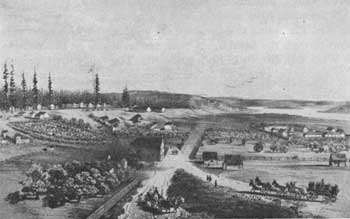





Survey of Historic Sites and Buildings
 |
VANCOUVER BARRACKS part of Vancouver National Historic Reserve Washington |
 |
| ||
Known at various times as Camp Vancouver (1849-50), Columbia Barracks (1850-53), Fort Vancouver (1853-79) and Vancouver Barracks (1879-present), this base was a key military headquarters and supply depot through World War II. Strategically located about 100 miles up the Columbia River, it was the nerve center of the campaigns against the Indians in the Pacific Northwest, highlighted by those in the 1850's and the Nez Perce War (1877). A troop-marshaling point and major command post, it was the headquarters in 1850-51 of the 11th Military District and for most of the period 1866-1920 of the Department of the Columbia. During the Spanish-American War and World Wars I and II, it was a mobilization and training center. Famed officers who served there in the course of their careers include Ulysses S. Grant, Philip H. Sheridan, George Crook, Oliver O. Howard, Nelson A. Miles, and George C. Marshall.
Like the second Fort Kearny, Nebr. (1848), Fort Laramie, Wyo. (1849), and Cantonment Loring, Idaho (1849), the post was founded to protect the Oregon Trail. In 1849, some 3 years after the United States gained full title to the region south of the 49th parallel from Great Britain, the Regiment of Mounted Rifle men and troops who had come by sea around Cape Horn established the fort adjacent to the Hudson's Bay Co. fur trading-agricultural post known as Fort Vancouver. From the time of its founding, at another nearby site, in 1824, the company post had been the economic, political social, and cultural hub of the Oregon country and nucleus of U:S. settlement there, especially because of the aid extended to emigrants by Dr. John McLoughlin, chief factor during the years 1824-46.
 |
| Gustav Sohon's tinted lithograph (1853) shows Vancouver Barracks on the hill at the left, and the Hudson's Bay Company post of Fort Vancouver on the right. (Bancroft Library, University of California) |
Hudson's Bay Co. officials, hoping the Army's presence would reduce the pressure on its possessions exerted by U.S. settlers, welcomed the troops. In time, however, friction mounted between the Americans and the British, the fur trade declined, and the Hudson's Bay Co. landholdings and livestock dwindled. Finally, in 1860, the company evacuated the post and turned over the buildings and land to the U.S. Army. But within 6 years, fire destroyed all the buildings.
By 1946 the Vancouver Barracks Military Reservation consisted of 640 acres. In that year the Army inactivated it as a Regular post, but retained 64 acres for Reserve training. The city of Vancouver, the Washington National Guard, and the National Park Service acquired the rest of the reservation. The National Park Service's 98 acres, utilized for the establishment of Fort Vancouver National Historic Site, included the Vancouver Barracks parade ground and the site of the Hudson's Bay Co. post.
 |
| Headquarters building (1849), Vancouver Barracks. (National Park Service) |
The structures at Vancouver Barracks are predominantly modern, but most of a row of 19th-century officers' quarters are still intact. Originally constructed of logs, they are all now clap-boarded and painted white. In the center of the row, at 1106 East Evergreen Boulevard, stands an imposing two-story structure, probably erected in l849. It was the headquarters building and the home of the commanding officer until 1887 and was then utilized for a number of years as an officers' mess. Owned by Vancouver School District #1, it houses the Ulysses S. Grant Museum, operated by the Soroptimist Club of Vancouver in recognition of Grant's tour of duty at the post as a young officer. Part of the clapboard has been removed to reveal the original log buildings, an excellent and well-preserved example of dovetailed-joint log construction. A short distance to the southeast, on the eastern end of the parade ground, is located the visitor center of Fort Vancouver National Historic Site. The national historic site commemorates the Hudson's Bay Co. post, part of which has been reconstructed southwest of the visitor center.
In 1996, the 366-acre Vancouver National Historic Reserve was established to protect adjacent, historically significant historical areas. It includes Fort Vancouver National Historic Site, as well as Vancouver Barracks, Officers' Row, Pearson Field, The Water Resources Education Center, and portions of the Columbia River waterfront. Gen. O. O. Howard House interprets the history of Vancouver Barracks and the Reserve.
 |
 |
http://www.cr.nps.gov/history/online_books/soldier-brave/sitea26.htm
Last Updated: 19-Aug-2005